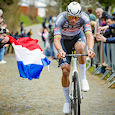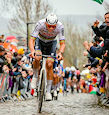In 2020, Van der Poel out-sprinted Van Aert in a two-man showdown. The following year, he was the one getting beaten at the line by Asgreen. In 2022, it looked like a head-to-head between him and Pogacar, but Van Baarle and Madouas suddenly appeared in the final metres—not that it mattered, as Van der Poel still won the sprint. In 2023, after a desperate chase from the Oude Kwaremont, he had to concede defeat to Pogacar. And last year, he soloed to victory from the Koppenberg.
The only time Van der Poel finished off the podium was in his debut year, 2019. After crashing 60 kilometres from the finish, he had to chase. He did so with style, but it took its toll, and he lacked the legs to respond when Bettiol attacked on the Oude Kwaremont. While the Italian soloed to victory, Asgreen slipped away in the final, and Van der Poel lost the sprint for third place to Kristoff.
The other top contender, Tadej Pogacar, raced De Ronde twice. As mentioned, he took victory in 2023 with a solo attack from the Oude Kwaremont, while Van der Poel outsmarted him the year prior.
The two hot favourites also served up a thrilling finale in the most recent edition of Milan-San Remo. Filippo Ganna played his part too, and despite relentless attacks from Pogacar, the spoils went to Van der Poel. In the sprint, he was well ahead of the other two—which implies that Pogacar has to drop him on the hills if he wants to stand a chance.
Van der Poel has only raced twice this season. Alongside his win in La Primavera, he also dominated the E3 Saxo Classic — so he’s running at a perfect 100% score. It’s hard to imagine he won’t be calling the shots in De Ronde as well. Pogacar, meanwhile, has been just as impressive, taking the overall victory at the UAE Tour and winning Strade Bianche.
This year’s High Mass of Flemish cycling is held on a 268-kilometre route. Which is hard in itself, but the relentless onslaught of (cobbled) climbs really makes it into a war of attrition. Virtually all ‘hellingen’ are situated in the second half of the race, while the Oude Kwaremont/Paterberg combo presents the last obstacles inside the last 20 kilometres. After the Paterberg the last 13.3 kilometres are flat.
Obviously, the decisive move in the Tour of Flanders happens inside the last 50 kilometres. Philippe Gilbert tops the list of long-range attacks in the last decade. In 2017, the now retired Walloon rode alone for more than 50 kilometres before winning the race in heroic style. Other solo winners are Peter Sagan (2016, attack on the Paterberg), Niki Terpstra (2018, attacks on Kruisberg/Hotond), Alberto Bettiol (2019, attack on Oude Kwaremont), and Tadej Pogacar (2023, also from Oude Kwaremont).
The Flemish classics of this season were won by Søren Wærenskjold (Omloop Het Nieuwsblad), Jasper Philipsen (Kuurne-Brussel-Kuurne), Nils Eekhoff (Nokere Koerse), Sebastián Molano (Brugge-De Panne), Mathieu van der Poel (E3 Saxo Classic), Mads Pedersen (Gent-Wevelgem), and Neilson Powless (Dwars door Vlaanderen).
Favourites 2025 Tour of Flanders
***** Mathieu van der Poel, Tadej Pogacar
**** Wout van Aert, Mads Pedersen
*** Matteo Jorgenson, Tim Wellens, Neilson Powless
** Filippo Ganna, Lennert Van Eetvelt, Jasper Stuyven, Tiesj Benoot
* Dylan van Baarle, Stefan Küng, Michael Matthews, Valentin Madouas
Tour of Flanders: videos
Click on the images to zoom




